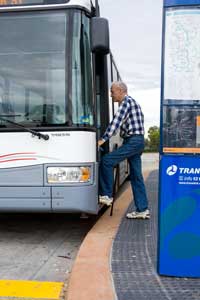Stay on your Feet® - The E's of injury prevention
The E's of injury prevention can easily be applied to falls prevention.
In 1973, Sue Baker [40] identified the first three E's of injury prevention:
Environment and product design or modification
Modifying the design of products and the environment, including individual dwellings, hospitals, residential aged care facilities, public buildings and the surrounding neighbourhood can ensure they are safe for people to live and use everyday [41]. This action also contributes to falls prevention.
Examples of environmental design include installing shaded seating in public places and replacing stairs with ramps, building bathrooms with grab rails, non-slip flooring and no shower hob.
Hip protectors are an example of product design.
Professional home assessment and modification for older people who have fallen have been found effective for falls prevention [56].
Environment and product design is considered a passive intervention where individuals are not required to undertake any action to be protected. These strategies have been found to be more effective for injury prevention than active measures, which require continued effort from individuals [20].
Interventions for falls require a combination of passive and active interventions, because falls are caused by a number of environmental and personal risk factors.

Enforcement of legislation and policies
Enforcement of legislation and policies combined with penalties for not following the legal requirements are used to influence the actions of individuals, organisations and businesses to reduce risk and injury [41]. Some of the greatest successes in injury prevention have been heralded from a combination of education and enforcement [20], for example: seatbelt use and fines for non-use.
Due to the number of personal risk factors for falls, enforcement mainly applies to environmental factors, for example: the Disability Standards for Accessible Public Transport 2002 [64]. These standards set out requirements in relation to provision of paths, ramps and handrails that enable people to easily and safely access public transport. Such provisions benefit older Australians and can contribute to preventing falls in the community.
Education
Falls prevention education aims to inform older people and key stakeholders including individuals, communities, health professionals, policy makers, businesses and the media, either one-on-one or on mass.
The aim of falls prevention education is to increase knowledge, alter their attitudes and encourage behaviour change.
However, it is important to note that education methods alone will not necessarily result in behavioural change. Education is considered an active intervention, which requires an individual to take action each time they undertake a safety measure [20, 41]. Success depends on the beliefs, efforts and actions of those that the education is targeting [41].
Education is useful when:
-
myths and misconceptions persist, such as the myth that environmental hazards are the main cause of falls
-
there is a need for new information to be made more widely available [41], for example: the early treatment of cataracts through surgery can reduce falls
-
when there is no other definitive way to prevent injuries, either through product changes, environmental design or legislation [41].
Overall, education plays an important role in laying the foundation for sound falls prevention approaches and healthy active ageing. It should not be used in isolation but as a part of an overall multi-strategic approach.
Education alone will not reduce falls.